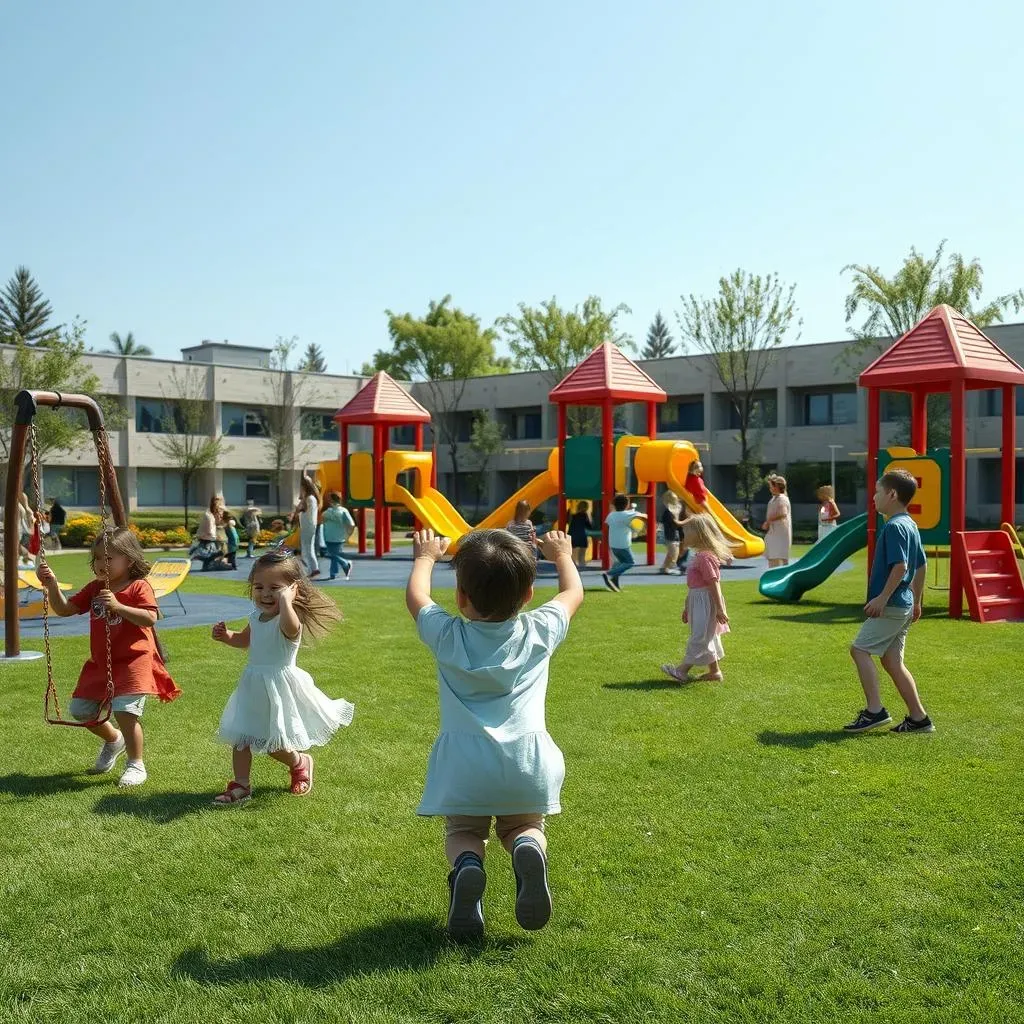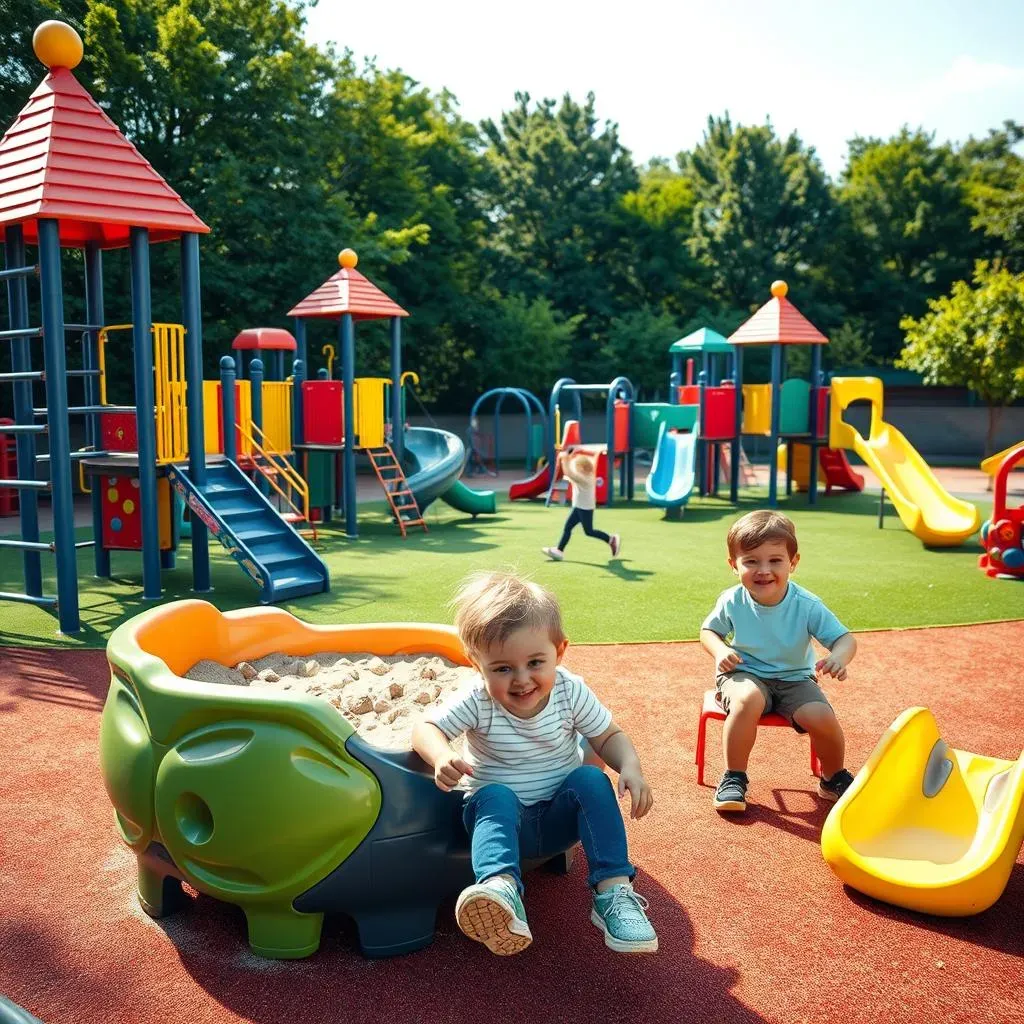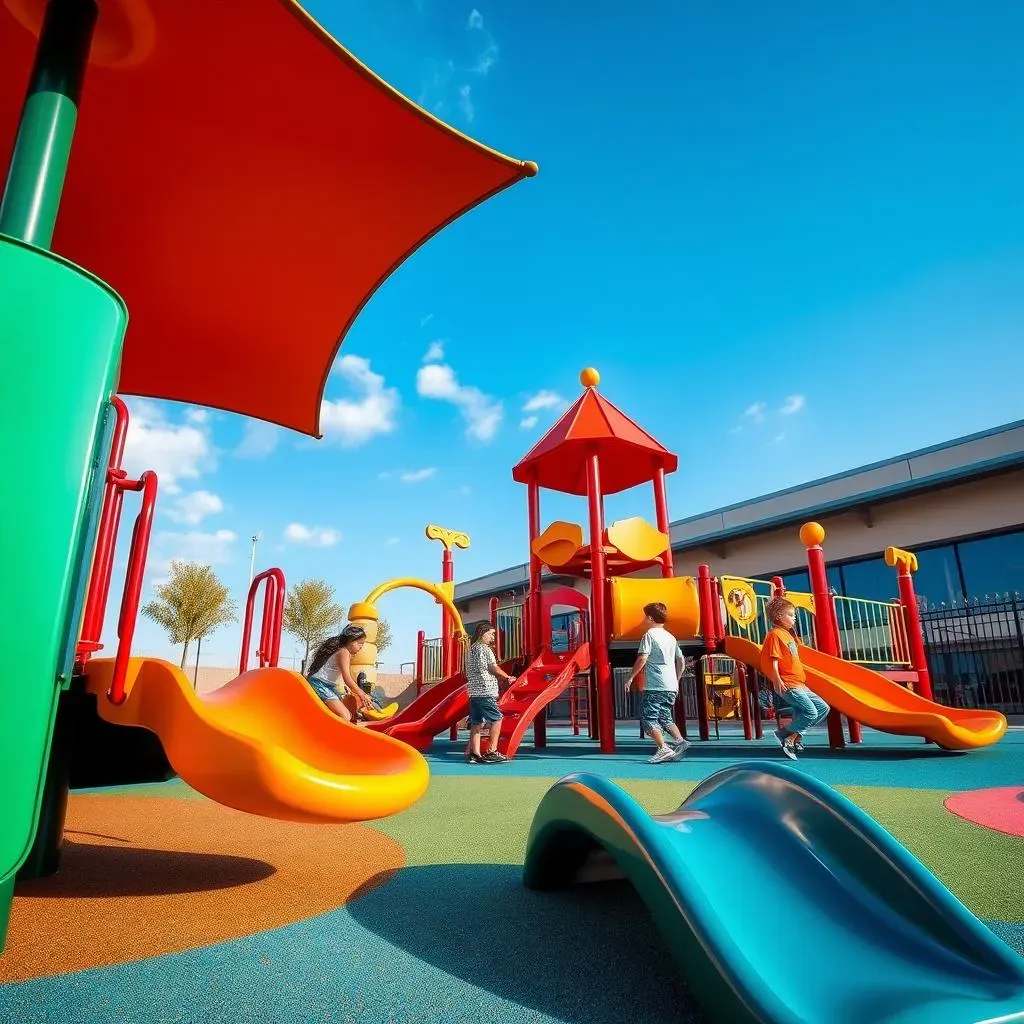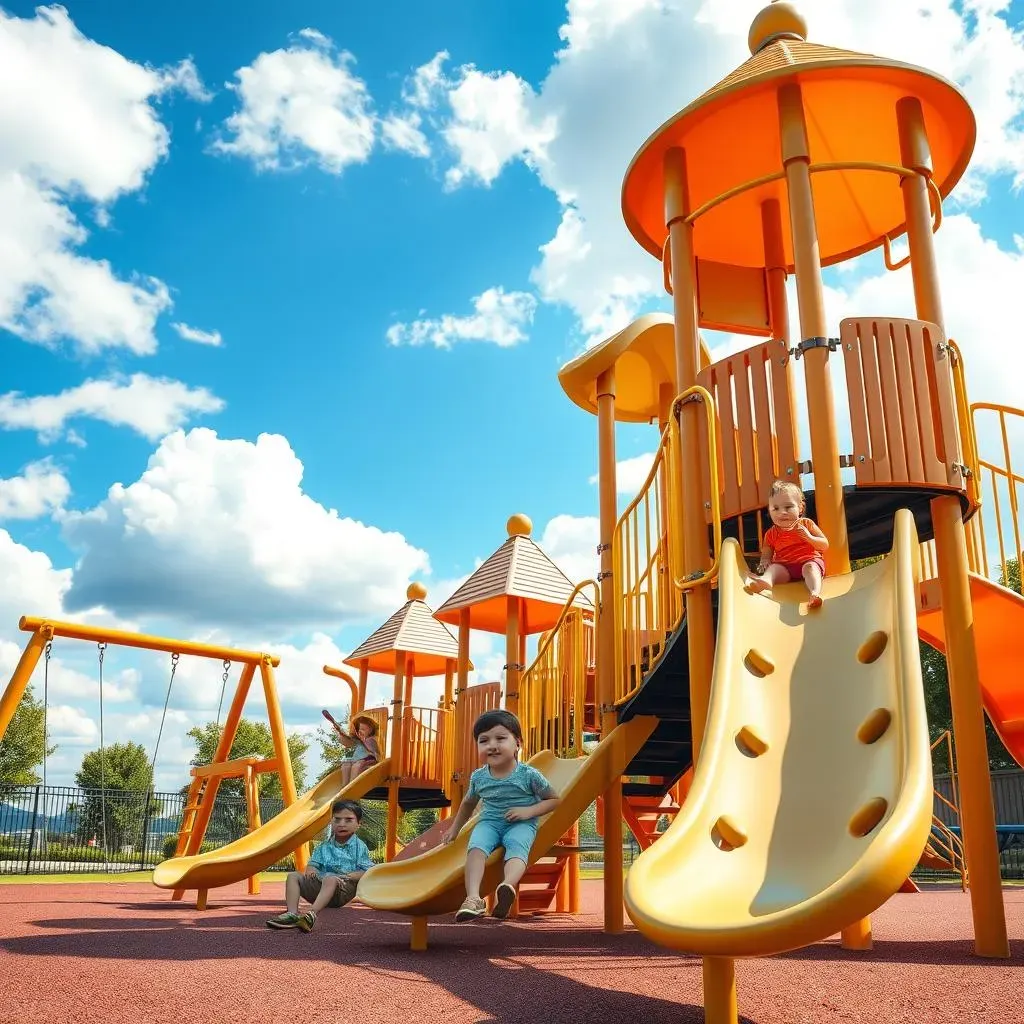Table of Contents
Ever wondered how to transform a simple outdoor space into a hub of laughter and activity? The answer often lies in choosing the right commercial playground equipment. Whether you're a school administrator, a daycare owner, or a community planner, selecting the perfect play structures is crucial for creating a safe and engaging environment for children. This article isn't just a list of products, it’s your guide to understanding what makes great commercial playground equipment. We'll explore how to pick the best options for your specific needs, focusing on durability, safety, and the developmental benefits of various play structures. We'll tackle the key questions about choosing the right equipment, from swings and slides to climbing frames and interactive play panels. By the end, you’ll be equipped with the knowledge to confidently create a play area that’s not only fun but also promotes healthy development. So, let's jump in and discover the world of commercial playground equipment together, ensuring your space becomes a place where kids can thrive.
Choosing the Right Commercial Playground Equipment

Choosing the Right Commercial Playground Equipment
Understanding Your Needs
So, you're diving into the world of commercial playground equipment? Awesome! First thing's first: it's not about picking the flashiest thing you see. It's all about understanding who will use the equipment. Are we talking toddlers, school-aged kids, or a mix of everyone? Think about the age range, their developmental stages, and what kind of play you want to encourage. Do you envision lots of running and climbing, or more collaborative, imaginative play? Maybe you need a mix of both. For example, a preschool might need more low-to-the-ground structures, while an elementary school can handle more challenging climbing frames. Knowing this from the get-go will save you time, money and a lot of headaches.
Also, consider the space you have available. Is it a wide-open field, or a cozy corner? Don't try to cram a massive structure into a tiny area. Think about how the equipment will fit, how kids will move around it, and if there's enough space for safe play. It's like trying to fit a giant puzzle piece in the wrong spot – it just won't work. Start with measuring your space and then sketch out a rough plan to help visualize everything. This is going to help you narrow down the type and size of equipment you should be looking at. It’s all about making sure the playground is both safe and fun.
User Group | Developmental Focus | Equipment Ideas |
|---|---|---|
Toddlers (1-3 years) | Gross motor skills, sensory exploration | Low slides, small climbers, sandboxes |
Preschoolers (3-5 years) | Social interaction, imaginative play | Playhouses, swings, simple climbing structures |
School-Aged Kids (6-12 years) | Physical challenges, teamwork | Climbing walls, complex structures, group swings |
Considering Your Budget
let’s talk about the fun part: money. I know, not everyone's favorite topic, but it's super important. Setting a realistic budget is key before you even start browsing. Commercial playground equipment can vary wildly in price, from basic swing sets to elaborate play structures that look like they belong in a theme park. Factor in not just the cost of the equipment but also installation, surfacing, and any future maintenance. It's not just about the initial price tag; it's about the long-term investment. Think of it like buying a car – you have the initial price, and then you've got gas, insurance, and maintenance. Same goes for playground equipment. And don’t forget to shop around, get quotes from different suppliers and compare. There are some good deals out there if you know where to look.
Also, while it's tempting to go for the cheapest option, remember that quality matters. You don't want to buy something that's going to fall apart in a year. Think of it like this: would you buy the cheapest parachute on the market? Probably not. The same logic should apply to playground equipment. Investing in durable and safe equipment means it will last longer, require less maintenance, and provide a better experience for the kids. So, balance your budget with the need for quality and safety. It’s all about making smart choices that will benefit everyone in the long run.
Commercial Playground Equipment for Different Needs

Commercial Playground Equipment for Different Needs
Equipment for Schools
so you're looking at playground equipment for a school? That's a whole different ball game! Schools need equipment that's not only fun but also promotes physical activity and teamwork. Think about what kind of skills you want to foster. Do you want to encourage kids to climb and explore, or are you more focused on cooperative play? Maybe you need a bit of everything. For example, a large climbing structure can help with physical development, while a set of swings can encourage social interaction. Don't forget about elements that can be used for organized games, like basketball hoops or soccer goals. It’s also a good idea to include some inclusive equipment, so kids of all abilities can participate.
Also, schools have a wide range of age groups to consider. You might need separate play areas for younger and older students. Younger kids, like those in preschool or kindergarten, need equipment that is low to the ground and easy to access. Think small slides, tunnels, and sandboxes. Older kids, on the other hand, need more challenging structures that test their strength and coordination. Think climbing walls, rope courses, and taller slides. It’s all about creating a space where every student feels challenged and engaged. And remember, safety is paramount. Make sure the equipment is durable, well-maintained, and meets all safety standards.
School Type | Typical Age Range | Recommended Equipment |
|---|---|---|
Preschool/Kindergarten | 3-5 years | Low slides, sandboxes, playhouses, small climbing structures |
Elementary School | 6-12 years | Climbing walls, larger slides, swings, group play structures |
Middle/High School | 13-18 years | Fitness equipment, obstacle courses, challenging climbing structures |
Equipment for Daycares
Daycares are another story entirely. Here, you’re often dealing with the littlest ones, so safety and accessibility are key. The equipment needs to be designed with toddlers and preschoolers in mind. Think about soft surfaces, low heights, and rounded edges. You're not looking for extreme challenges, but rather opportunities for exploration and sensory play. Things like small slides, tunnels, and playhouses are great choices. Sand and water play areas can also be a big hit, allowing kids to explore different textures and engage in imaginative play. The goal is to create a space where little ones can learn and grow while having fun.
Also, daycares often need equipment that is versatile and can be used in different ways. Space can be limited, so you need to make the most of what you have. Consider multi-functional play structures that can be climbed, crawled through, and slid down. And don't forget about the importance of social interaction. Choose equipment that encourages kids to play together and develop their social skills. Think about swings, see-saws, and small play tables where kids can gather and interact. The key is to create a space that is both safe and stimulating for young minds.
Equipment for Parks and Communities
Finally, let's talk about parks and community spaces. These areas need equipment that caters to a wide range of ages and abilities. You're not just thinking about kids, but also families and adults who might want to use the space for exercise or relaxation. Think about creating a mix of play structures, fitness areas, and seating options. You might include a large climbing structure for older kids, a swing set for younger ones, and some outdoor fitness equipment for adults. It’s all about creating a space where everyone feels welcome and can enjoy the outdoors.
Also, consider the community’s needs and preferences. What kind of activities are popular in your area? Do you need a basketball court, a skate park, or a splash pad? These are all things to think about when planning a community play space. And don't forget about the importance of accessibility. Make sure the equipment is designed so that people of all abilities can participate. This means including ramps, wide pathways, and adaptive play structures. The goal is to create a space that is inclusive, fun, and beneficial for everyone in the community. Remember, a well-designed community playground can be a source of pride and enjoyment for years to come.
Safety and Durability of Commercial Playground Equipment

Safety and Durability of Commercial Playground Equipment
The Importance of Safety
so we’ve talked about fun and play, but let’s be real, safety is the name of the game when it comes to commercial playground equipment. No one wants to see a kid get hurt, right? That's why it's super important to choose equipment that meets all the safety standards. Look for certifications from reputable organizations, and make sure that everything is designed with kids in mind. Think about things like impact-absorbing surfaces, rounded edges, and no sharp points. It's all about minimizing risks and creating a safe play environment. It's kind of like building a house - you wouldn’t skip the foundation, would you? Same thing here, safety is the foundation of a good playground.
Also, regular inspections are key. It's not enough to just install the equipment and forget about it. You need to check it regularly for any signs of wear and tear, loose bolts, or damage. Think of it like taking care of a car – you wouldn't drive it without checking the tires, would you? The same goes for playground equipment. Regular maintenance can help prevent accidents and prolong the life of the equipment. And remember, safety isn’t just about the equipment itself, it's also about the surrounding area. Make sure there’s enough space around the structures, and that the ground is free of hazards. It's all about creating a safe and secure space for kids to play.
Safety Aspect | Considerations |
|---|---|
Surfacing | Impact-absorbing materials, proper depth |
Equipment Design | Rounded edges, no sharp points, age-appropriate |
Regular Inspections | Check for wear and tear, loose parts, damage |
Durability and Materials
Now, let's chat about durability, because what's the point of having a playground if it's going to fall apart after a few uses? You need to choose materials that are tough and can handle all kinds of weather and all the wear and tear from energetic kids. Think about things like steel, high-density polyethylene, and treated wood. These materials are known for their strength and resistance to rust, rot, and fading. It's like choosing the right tools for a job – you wouldn't use a plastic hammer to build a house, would you? The same logic goes for playground equipment. The better the materials, the longer the equipment will last.
Also, consider the climate in your area. If you live in a place with harsh winters or hot summers, you'll need equipment that can withstand those conditions. Look for materials that are UV-resistant and can handle extreme temperatures. It’s also a good idea to choose equipment that is easy to clean and maintain. You don't want to spend hours scrubbing grime off the play structures. Think about the long term – investing in durable materials will save you time and money in the long run. It’s all about making smart choices that will benefit everyone in the long run.
Long-Term Maintenance
Finally, let’s talk about maintenance. It’s not just about buying the equipment, it’s also about keeping it in good shape for years to come. Regular maintenance is key to ensuring the safety and longevity of your playground. Think about things like tightening bolts, replacing worn parts, and cleaning surfaces. It’s like taking care of a bike – you wouldn’t just ride it without checking the brakes, would you? The same goes for playground equipment. A little bit of maintenance goes a long way. Also, consider the resources needed for maintenance. Do you have the staff or tools to handle it yourself, or will you need to hire a professional? These are all things to think about when planning your playground.
Also, keep an eye out for any signs of damage or wear and tear. Early detection can prevent minor issues from becoming major problems. Think about it like this: would you ignore a small leak in your roof? Probably not. The same logic applies to playground equipment. Addressing issues early on can save you time, money, and headaches in the long run. And remember, a well-maintained playground is not only safer but also more enjoyable for the kids. It shows that you care about their well-being and are committed to providing a fun and safe environment. It’s all about making a long-term investment in the community.
Installation and Maintenance of Commercial Playground Equipment

Installation and Maintenance of Commercial Playground Equipment
Professional Installation vs. DIY
Alright, so you've picked out your awesome commercial playground equipment, now comes the big question: who's gonna put it together? You've got two main paths: professional installation or the DIY route. Going pro means you're hiring a team of experts who know their way around playground structures. They have the tools, the experience, and the know-how to ensure everything is installed correctly and safely. It's like hiring a chef to cook a fancy meal – they know all the steps and have the right equipment. This option is great if you want to be sure the job is done right, and you don't want the headache of figuring it out yourself. However, it can be more expensive than doing it yourself.
On the other hand, DIY installation means you're taking on the project yourself, or with a group of handy helpers. This can save you money, and it can be a rewarding experience to build the playground yourself. It's like assembling your own furniture – you feel a sense of accomplishment when it's done. But, DIY installation requires time, patience, and a good understanding of the instructions. You'll also need to have the right tools and equipment. It's crucial to follow the manufacturer's instructions to a T, because safety is paramount. If you're not comfortable with construction, it's probably best to leave it to the professionals. It’s all about making sure the playground is both safe and fun.
Installation Method | Pros | Cons |
|---|---|---|
Professional Installation | Expertise, safety, efficiency | Higher cost |
DIY Installation | Cost savings, sense of accomplishment | Requires time, tools, and knowledge |
Step-by-Step Installation Guide
so let's say you're going the DIY route. What does that actually involve? Well, first things first, read the instructions carefully. I know, it's tempting to just jump in, but trust me, taking the time to understand the process is crucial. Next, make sure you have all the tools you need: wrenches, levels, measuring tape, the whole shebang. It’s kind of like making a recipe – you can’t skip an ingredient, right? Then, lay out all the parts and double-check that everything is there. This will save you time and frustration later on. And remember, safety first! Wear protective gear, and take breaks when needed.
Once you've got everything prepped, start assembling the structure according to the instructions. Pay close attention to the order of the steps, and make sure everything is properly aligned and tightened. It’s like building with LEGOs – if you don’t follow the instructions, things can go wrong pretty fast. And remember, if you’re unsure about anything, don’t hesitate to reach out to the manufacturer or a professional for guidance. It’s better to be safe than sorry. Once the structure is up, check it thoroughly to make sure everything is secure and stable. A proper installation is essential for ensuring the safety and longevity of your playground. It’s all about getting it right from the start.
Regular Maintenance Checklist
Now that your playground is up and ready to go, the work isn’t over. Regular maintenance is key to keeping it safe and fun for years to come. Think of it like taking care of a garden – you can’t just plant it and forget about it. You need to water it, weed it, and prune it. The same goes for playground equipment. Start by creating a maintenance checklist, and stick to it. This should include things like tightening bolts, checking for rust or damage, and cleaning surfaces. It’s all about preventing small problems from becoming big ones.
Also, pay attention to the surfacing around the playground. Make sure it’s still impact-absorbing and free from hazards. Check for any signs of wear and tear, and replace materials as needed. Don’t forget to inspect the play structures themselves. Look for loose parts, cracks, or any other signs of damage. And remember, a little bit of maintenance goes a long way. A well-maintained playground is not only safer but also more enjoyable for the kids. It shows that you care about their well-being and are committed to providing a fun and safe environment. It’s all about making a long-term investment in the community.
- Check for loose bolts and screws.
- Inspect for rust, cracks, or damage.
- Clean surfaces regularly.
- Ensure surfacing is safe and impact-absorbing.
- Replace worn or damaged parts promptly.
Wrapping Up Your Playground Project
Choosing the right commercial playground equipment is an investment in the future, creating spaces where children can grow, learn, and play. It's about more than just installing structures; it’s about fostering community, encouraging physical activity, and sparking imagination. Remember to prioritize safety, consider the diverse needs of your users, and always look for durable, high-quality equipment that will last for years to come. With the right approach, your playground can become a cherished space for everyone involved. So, go ahead, create that amazing play area and watch the fun unfold!